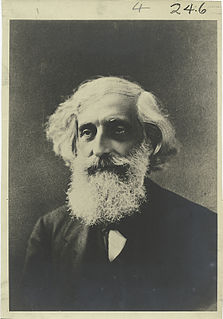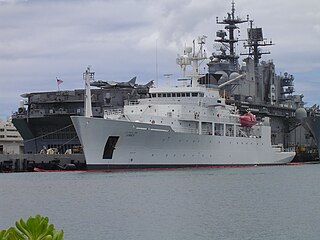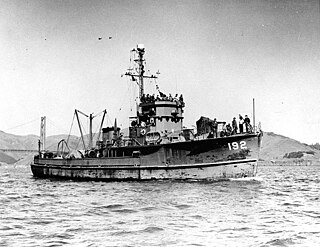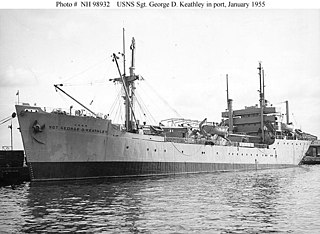Sumner has been the name of four ships in the United States Navy. The destroyers, DD-333 and DD-692, were named after World War I Marine Corps Captain Allen Melancthon Sumner. The survey ships, AGS-5 and T-AGS-61, were named after the 19th century Navy captain Thomas Hubbard Sumner.
USS or USNS Maury may refer to the following ships, named for Commodore Matthew Fontaine Maury:

William Chauvenet was a professor of mathematics, astronomy, navigation, and surveying who was instrumental in the establishment of the U.S. Naval Academy at Annapolis, Maryland, and later the second chancellor of Washington University in St. Louis.

USNS Sumner (T-AGS-61) is a Pathfinder-class oceanographic survey ship that became operational in 1997. It is the fourth United States Navy ship named Sumner. These ships are crewed by a small crew of civilian mariners, supporting an even smaller contingent of United States Navy personnel.

USS Towhee (AM-388) was an Auk-class minesweeper acquired by the United States Navy for the dangerous task of removing mines from minefields laid in the water to prevent ships from passing.

The YMS-1 class of auxiliary motor minesweepers was established with the laying down of YMS-1 on 4 March 1941. Some were later transferred to the United Kingdom as part of the Second World War Lend-Lease pact between the two nations. One ship eventually made its way into the Royal Canadian Navy postwar.

USS Simon Newcomb (AGSC-14/YMS-263) was a YMS-1-class minesweeper of the YMS-135 subclass acquired by the U.S. Navy during World War II, and whose task was assisting in minesweeping and surveying coastal waters.

USS Reedbird (AMS-51/YMS-291) was a YMS-1-class minesweeper of the YMS-135 subclass acquired by the U.S. Navy for the dangerous task of removal of mines that had been placed in coastal waters to prevent ships from passing.

USS Chauvenet (AGS-11/YMS-195) was a YMS-1-class minesweeper of the YMS-135 subclass built for the United States Navy during World War II. She was constructed as USS YMS-195 at the Hiltebrant Dry Dock Company of Kingston, New York, and was laid down on 3 April 1942, launched on 10 August 1942, and commissioned on 20 March 1943.

USS Harkness (AMCU-12/YMS-242) was a YMS-1-class minesweeper of the YMS-135 subclass acquired by the U.S. Navy for the task of removing mines that had been placed in the water to prevent ships from passing.

USS James M. Gilliss (AMCU-13/YMS-262) was a YMS-1-class minesweeper of the YMS-135 subclass named after James Melville Gilliss, a US naval officer credited with establishing the US Naval Observatory.

RV Sir Horace Lamb was a Navy owned former mine warfare vessel assigned to the Columbia University, Geophysical Field Station research facility in Bermuda for acoustic research operating from 1959 to 1976. The ship was the former USS Redpoll (AMS-57/YMS-294), a YMS-1-class minesweeper of the YMS-135 subclass built and commissioned as YMS-294 in 1943.

USS Hummer (AMS-20/YMS-372) was a YMS-1-class minesweeper of the YMS-135 subclass acquired by the U.S. Navy for the task of removing mines that had been placed in the water to prevent ships from passing.

USS Jackdaw (AMS-21/YMS-373) was a YMS-1-class minesweeper of the YMS-135 subclass built for the United States Navy during World War II. She was the third U.S. Navy ship to be named for the jackdaw.
USS James M. Gilliss may refer to one of the following United States Navy ships:
USS Bowditch or USNS Bowditch may refer to:

USNS Sgt. George D. Keathley, was a World War II United States cargo vessel that was used for troop transport and later converted to a survey vessel. She was laid down and launched as MS Alexander R. Niniger, Jr., then renamed MS Acorn Knot. She was put into US Army service as USAT Acorn Knot, then renamed USAT Sgt. George D. Keathley. She was transferred to the US Navy and became USNS Sgt. George D. Keathley (T-APC-117), but was later re-designated T-AGS-35. She was leased to the Republic of China, where she served as Chu Hwa (AGS-564). Both Nininger and Keathley were posthumous Medal of Honor recipients.

USNS John McDonnell (T-AGS-51) was a hydrographic survey ship operated by the Military Sealift Command (MSC) with a contract crew for the Naval Oceanographic Office which assigned a military and civilian hydrographic detachment to conduct coastal surveys. The ship and its sister, USNS Littlehales (T-AGS-52), were replacements for the coastal hydrographic survey vessels USNS Chauvenet (T-AGS-29) and USNS Harkness (T-AGS-32).

USNS Chauvenet (T-AGS-29) was a coastal survey ship laid down on 24 May 1967, at Upper Clyde Shipbuilding Corp., Glasgow, Scotland. The ship was the second survey ship, Chauvenet (AGS-11) being the first, named for William Chauvenet (1820-1870). He was instrumental in the founding of the United States Naval Academy at Annapolis, MD. The mathematics department of the US Naval Academy in Annapolis was founded by Chauvenet and is housed in Chauvenet Hall. Chauvenet was launched on 13 May 1968, delivered to the US Navy, 13 November 1970 and placed in service with the Military Sealift Command (MSC) as USNS Chauvenet (T-AGS-29). The ship conducted coastal hydrographic and topographic surveys under the technical direction of the Oceanographer of the Navy through the U.S. Naval Oceanographic Office (NAVOCEANO). The ship was assigned to the Pacific for surveys, sister ship Harkness (T-AGS-32) was assigned Atlantic duties, doing so until inactivated in November 1992.
This page is based on this
Wikipedia article Text is available under the
CC BY-SA 4.0 license; additional terms may apply.
Images, videos and audio are available under their respective licenses.












